A friend just returned from a Montana hunting trip and was thoughtful enough to bring me a couple cottonwood and aspen logs for turning. These species are not available in NC where I live and I am just wondering what to expect. Anybody here ever turned those species?
-
December 2025 Turning Challenge: Single Tree! (click here for details) -
Congratulations to Bob Henrickson, People's Choice in the November 2025 Turning Challenge (click here for details) -
Congratulations to Guillaume Fontaine for "Old Tea Pot" being selected as Turning of the Week for December 15, 2025 (click here for details) -
Welcome new registering member. Your username must be your real First and Last name (for example: John Doe). "Screen names" and "handles" are not allowed and your registration will be deleted if you don't use your real name. Also, do not use all caps nor all lower case.
You are using an out of date browser. It may not display this or other websites correctly.
You should upgrade or use an alternative browser.
You should upgrade or use an alternative browser.
Cottonwood and Aspen
- Thread starter Wally Crawford
- Start date
I have been turning a fair amount of cottonwood lately. It turns well. Its not particularly hard, but not particularly soft either. It often has good figure, frequently has natural staining, often has darker heartwood depending on the size. It sands to a pretty good sheen naturally, takes a nice finish.
It does NOT seem to stain well...went down this experimental staining path a few times. I tried it with cottonwood each time, as a treecutter friend had a TON of cottonwood he needed to get rid of (too many wood piles, neighbors complaining), so I've been taking a lot of it. It just does not stain well. It finishes fine with standard finishes, but when it comes to stain the fibers of the wood, even with a pre-stain conditioner, just do not absorb the stain in any way resembling consistent or even. So I wouldn't stain cottonwood.
Aspen is similar, its not a harder wood, its a bit softer. With the aspen I've turned, it doesn't turn as well as the cottonwood. But, it does have this internal staining around the heartwood that is quite nice. Being slightly on the softer side its very easy to turn. I had a tough time getting it to take spar or poly finishes well. Don't know if it was just the particular species or not. IT was very, very dry wood. It took my more standard shellac + acks finish fine, but that's not a particularly durable finish.
I don't think I have any of the aspen pieces around, but here are some of the cottonwood pieces I've turned recently: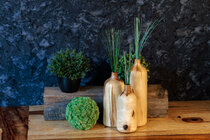
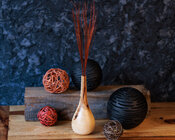
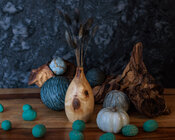
I like the cottonwood for its variation and figure. Almost every piece I have has some figure, most has some natural staining. Just makes for more interesting wood, I think. It takes a finish very nicely.
It does NOT seem to stain well...went down this experimental staining path a few times. I tried it with cottonwood each time, as a treecutter friend had a TON of cottonwood he needed to get rid of (too many wood piles, neighbors complaining), so I've been taking a lot of it. It just does not stain well. It finishes fine with standard finishes, but when it comes to stain the fibers of the wood, even with a pre-stain conditioner, just do not absorb the stain in any way resembling consistent or even. So I wouldn't stain cottonwood.
Aspen is similar, its not a harder wood, its a bit softer. With the aspen I've turned, it doesn't turn as well as the cottonwood. But, it does have this internal staining around the heartwood that is quite nice. Being slightly on the softer side its very easy to turn. I had a tough time getting it to take spar or poly finishes well. Don't know if it was just the particular species or not. IT was very, very dry wood. It took my more standard shellac + acks finish fine, but that's not a particularly durable finish.
I don't think I have any of the aspen pieces around, but here are some of the cottonwood pieces I've turned recently:



I like the cottonwood for its variation and figure. Almost every piece I have has some figure, most has some natural staining. Just makes for more interesting wood, I think. It takes a finish very nicely.
Dave Landers
Beta Tester
Cottonwood ranges from fantastic figure with great chatoyance, to bland and boring and plain. Pieces with the good figure are great. I do find it somewhat challenging to turn - it does like to tear out. So it takes sharp tools and good technique (the bland pieces are great for gouge practice. I find that the figured wood takes dye really well - I usually do a dark color like red first, then lighter like yellow on top - that really brings out the figure as the dye soaks into different areas of the figure differently.
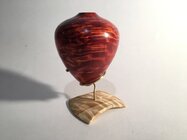
Aspen can have some nice color variations, especially around knots. It's soft and likes to tear out, so it also can be challenging to turn well. Again, sharp tools and good technique. I find it's pretty stable around the pith, so I like doing end-grain hollow forms around the pith.
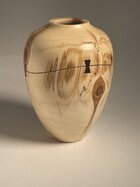

Aspen can have some nice color variations, especially around knots. It's soft and likes to tear out, so it also can be challenging to turn well. Again, sharp tools and good technique. I find it's pretty stable around the pith, so I like doing end-grain hollow forms around the pith.

Renowned lamp shape turner Peter Bloch used aspen. According to him it has the best translucence of all woods.

 www.woodshades.com
www.woodshades.com
A large easter egg box I turned from aspen
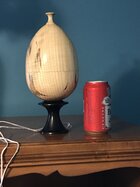
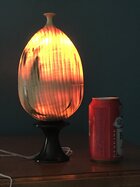

About Peter — Woodglow
A large easter egg box I turned from aspen


I turned a cottonwood burl that a friend dropped off years back. I was going to throw the wood out as I thought it was too soft to turn. Glad now that I didn't.
Saddly I took it to our club for show and tell, and when I went to take it home, it had a lot of the bark broken off. This has happened a few times and I no longer bring natural edged pieces for show and tell.
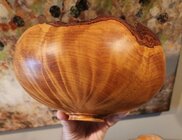
Saddly I took it to our club for show and tell, and when I went to take it home, it had a lot of the bark broken off. This has happened a few times and I no longer bring natural edged pieces for show and tell.


I did try to turn some cotton wood, and gave up on it. One reason it smells like some one barfed on it, very sour smell. Not sure if the smell ever goes away. I had some big leaf maple once that had the sour smell, and it didn't go away as the wood dried. I guess this is in part because it can and does hold a lot of water for a very long time. It is one of Mike Mahoney's favorite woods. As said, it does take major effort to get it to cut cleanly. I don't see much aspen here in Oregon. It is a very light colored wood, and most of what I have seen is rather blah. Main use for it in turning seems to be the translucent lamp shade turnings.
robo hippy
robo hippy
Greetings from Montana. First off, please ask your friend not to do the reverse and bring bark-on ash or walnut into Montana, where we don't yet have the diseases common to those trees in other areas.
Secondly, you've received good feedback above. Most of the turners in our area will not turn poplar/cottonwood. Around here, it's generally fuzzy/shaggy when turned and quite soft. The base, and apparently other areas of stress, can have nice figure, and some trees seem to turn better, with little fuzz. (My theory is that poplar/cottonwood growing in dry areas are better for turning than those growing along creeks or seasonal water courses. You'll have to see what you've got.)
Aspen, while a poplar family member, seems much less likely to fuzz or tear out. In our area, it's a little less soft than poplar, and the older trees have beautiful color. Newer wood is like basswood--Boring! If you have not turned aspen before, be aware that it turns so nicely and so fast, that before you know it, your bowl blank is a coaster. It's a very friendly wood, like myrtle or mesquite perhaps, and great for new turners, but makes it hard to go back to maple again.
Secondly, you've received good feedback above. Most of the turners in our area will not turn poplar/cottonwood. Around here, it's generally fuzzy/shaggy when turned and quite soft. The base, and apparently other areas of stress, can have nice figure, and some trees seem to turn better, with little fuzz. (My theory is that poplar/cottonwood growing in dry areas are better for turning than those growing along creeks or seasonal water courses. You'll have to see what you've got.)
Aspen, while a poplar family member, seems much less likely to fuzz or tear out. In our area, it's a little less soft than poplar, and the older trees have beautiful color. Newer wood is like basswood--Boring! If you have not turned aspen before, be aware that it turns so nicely and so fast, that before you know it, your bowl blank is a coaster. It's a very friendly wood, like myrtle or mesquite perhaps, and great for new turners, but makes it hard to go back to maple again.
It is kind of soft wood, and you have to be able to turn wood with sharp gouges, they are not good candidates for scrapers that is for sure  .
.
I have turned several of these Poplar species trees, and they do. ask for your attention and keep the tools cutting.
Some of these woods do smell when wet, like some Elm species, however when dry the smell in gone and you are not able to smell any of these woods, I have a couple of these here in our house and there is no problem with smells.
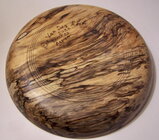
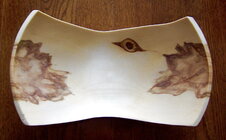
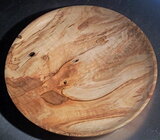
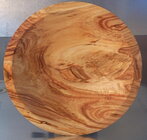
As you can see these pieces can be quite nice, just not an easy turning wood though
I have turned several of these Poplar species trees, and they do. ask for your attention and keep the tools cutting.
Some of these woods do smell when wet, like some Elm species, however when dry the smell in gone and you are not able to smell any of these woods, I have a couple of these here in our house and there is no problem with smells.




As you can see these pieces can be quite nice, just not an easy turning wood though
Very sharp tools, I sharpen often. Doesn't matter how sharp/cleanly cut, it will come out furry requiring a bit of sanding. I get quite a bit of cotton wood but only use it when I'm short on other woods. It does smell like cat urine when cut but smell goes away when dry. It can have some nice figure but that's far and few between. I have *bounced* or hit the wood with a fingernail, it leaves a mark so it's fairly soft. Right now I'm using several pieces painting glossy black on outside and glossy/clear on inside (bowl) but it's not going easy for me.
Thanks for the info and pics guys. The pics are really helpful in what to expect and I an looking forward to getting into it.
Have any of your guys ever tried live edge with the Cottonwood? This stuff is so wet that it will be a couple months until I can turn it, but love the bark and was thinking live edge.
If you look at the picture of mine, thats a bark edge but some was broke off by fellow club members.
I bought a piece of live edge California Cottonwood a couple years ago. The intent was to turn a live edge bowl with the bark on.Have any of your guys ever tried live edge with the Cottonwood? This stuff is so wet that it will be a couple months until I can turn it, but love the bark and was thinking live edge.
It was a very green piece, so I decide to let it dry a bit. Within a couple months I noticed the bark was separating. It also took on a very fibrous nature, and as the price dried more, the bark just flayed into strands. My original plan was kind of shot, do I set it aside.
Pulled it out earlier this year, and most of the bark just came off... I was suddenly looking at some burl and large cavities in the blank. The large bark structure crumbled onto pieces and fibers, useless at that point.
The blank is now slated for a resin project. I'd have done it already except my pressure pot seems to have a slow leak, and until can get that fixed, this piece is still on hold.
It may be species dependent, but after messing with a bunch of Cottonwood (California and Colorado) at this point, the bark, once dry, seems to be a largy unusable fibrous mess. If you want live edge, I would remove the bark first.
Poplar species have thicker cambium than most other tree species, leaving whole green logs or big chunks sit and try the dry it some (it never works without degrade) it is the wrong approach.I bought a piece of live edge California Cottonwood a couple years ago. The intent was to turn a live edge bowl with the bark on.
It was a very green piece, so I decide to let it dry a bit. Within a couple months I noticed the bark was separating. It also took on a very fibrous nature, and as the price dried more, the bark just flayed into strands. My original plan was kind of shot, do I set it aside.
Pulled it out earlier this year, and most of the bark just came off... I was suddenly looking at some burl and large cavities in the blank. The large bark structure crumbled onto pieces and fibers, useless at that point.
The blank is now slated for a resin project. I'd have done it already except my pressure pot seems to have a slow leak, and until can get that fixed, this piece is still on hold.
It may be species dependent, but after messing with a bunch of Cottonwood (California and Colorado) at this point, the bark, once dry, seems to be a largy unusable fibrous mess. If you want live edge, I would remove the bark firsPoplar species there is thicker
The wood will split and check and the bark will come off, especially if the tree was cut when still growing (dead standing trees have splits and the bark loose)
Best bet is cutting trees when growth has basically stopped, (the cambium will be thin and stronger, like in the winter, then turn the wood right away and with an even wall thickness of around 10%.
Dry it slowly (I prefer to dry it in a brown paper bag), and keep a close eye on the piece as it is drying, as fungus can appear and you should wipe that off of the piece and change the paper bag for a dry one, the fungus can stay alive until the woods moisture gets below 20%, when drier, the piece can be taken out of the bag and left to dry fully, sanded and finish applied.
Poplar species have thicker cambium than most other tree species, leaving whole green logs or big chunks sit and try the dry it some (it never works without degrade) it is the wrong approach.
The wood will split and check and the bark will come off, especially if the tree was cut when still growing (dead standing trees have splits and the bark loose)
Best bet is cutting trees when growth has basically stopped, (the cambium will be thin and stronger, like in the winter, then turn the wood right away and with an even wall thickness of around 10%.
Dry it slowly (I prefer to dry it in a brown paper bag), and keep a close eye on the piece as it is drying, as fungus can appear and you should wipe that off of the piece and change the paper bag for a dry one, the fungus can stay alive until the woods moisture gets below 20%, when drier, the piece can be taken out of the bag and left to dry fully, sanded and finish applied.
The logs I have were mostly dried before I got them. This tree cutter had big piles of wood, spanning back a month to over a year. Those were pretty dry, although interestingly, there was very little cracking or checking, except just on the very ends of the log where the open endgrain was.
The blank that had the bark peel off, was actually 100% fully wax sealed. I bought it from Cook Woods, several years ago. I had figured, being fully sealed, that it would dry slowly and without issues. The way the bark dried and peeled off, though, surprised me. In the long run, that was actually nice, as it revealed the burl below. Its not the most exquisite burl, but there are areas now that I can fill with resin to make something even more interesting than I had originally planned. The original idea was to just have this live edge, bark edge bowl, and I figured I would have to stabilize the bark pretty thoroughly anyway once it was dry.
I don't know why the bark peeled off the way it did, given even the bark was fully coated in wax. I actually was having a bit of a conundrum figuring out how to get the wax off of/out of the bark...
If you think that you can have a log with or without the bark on it dry in 1 year or less, I think you are dreaming.
Even softwood takes a year to dry 1 inch thick wood, and that is what is taken as the rule of thumb, 1" per year to dry, even that does not apply to thicker wood.
Like I said, get a just cut down log, and start turning it, turned to a 1" thick wall you can then put that in a brown paper bag ( nothing else in with it like shavings or saw dust), set that away in a cool spot and let it dry, just check that there is no fungus starting to grow on it (wipe that off and replace the bag with a dry one).
If you do this with at proper time cut logs, you will get nice dry turnings with no splits, bark will stay on also.
And yes I do know what I am talking about, been turning for better than 60 year, never bought my wood, (but for small tropical pieces) always turning from raw wood that I would either cut down or got from the cities wood dump.
Here are two pictures (I have shown them before) this is a load of over 1000 bowls ( yes I counted them)
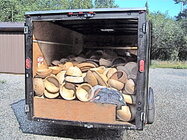
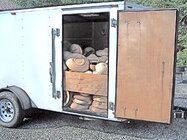
Even softwood takes a year to dry 1 inch thick wood, and that is what is taken as the rule of thumb, 1" per year to dry, even that does not apply to thicker wood.
Like I said, get a just cut down log, and start turning it, turned to a 1" thick wall you can then put that in a brown paper bag ( nothing else in with it like shavings or saw dust), set that away in a cool spot and let it dry, just check that there is no fungus starting to grow on it (wipe that off and replace the bag with a dry one).
If you do this with at proper time cut logs, you will get nice dry turnings with no splits, bark will stay on also.
And yes I do know what I am talking about, been turning for better than 60 year, never bought my wood, (but for small tropical pieces) always turning from raw wood that I would either cut down or got from the cities wood dump.
Here are two pictures (I have shown them before) this is a load of over 1000 bowls ( yes I counted them)


If you think that you can have a log with or without the bark on it dry in 1 year or less, I think you are dreaming.
Even softwood takes a year to dry 1 inch thick wood, and that is what is taken as the rule of thumb, 1" per year to dry, even that does not apply to thicker wood.
Like I said, get a just cut down log, and start turning it, turned to a 1" thick wall you can then put that in a brown paper bag ( nothing else in with it like shavings or saw dust), set that away in a cool spot and let it dry, just check that there is no fungus starting to grow on it (wipe that off and replace the bag with a dry one).
If you do this with at proper time cut logs, you will get nice dry turnings with no splits, bark will stay on also.
And yes I do know what I am talking about, been turning for better than 60 year, never bought my wood, (but for small tropical pieces) always turning from raw wood that I would either cut down or got from the cities wood dump.
Here are two pictures (I have shown them before) this is a load of over 1000 bowls ( yes I counted them)
View attachment 69301
View attachment 69302
I'm not really sure who you are debating here? I was never trying to argue with you...
I am aware of the twice-turned process. I've done it, but I have troubles with turning green wood here in very arid colorado. Things check and crack during turning if the wood is green (well, for a lot of woods, some woods don't have this problem.). Checking is often turned away on the second turning, though not always. Cracks that occur, which has definitely occurred with green cottonwood for me before, will usually not turn away in the second turning. I mostly turn dry wood these days. I may get back into green wood twice-turning at some point, but its a long process, I sell a lot of what I make, and waiting a long time for first-turned bowls to dry isn't something I can accommodate right now. (Hopefully I'll cross a threshold at some point here where that simply does not matter, time will tell I guess.)
Also, regarding the cottonwood BLANK (I have both pre-cut, wax-sealed bowl blanks, as well as logs I've picked up...I was talking about bark peeling off one of the BLANKS, not logs). I never said the wood was dry. I said the bark fibered out and flaked and peeled off the wood. That was DEFINITELY far less than a year. It was just a few months. The piece was green when I bought it. It had just been cut down recently, according to the seller. It was fully wax sealed. I was never trying to argue with you or debate you. or even say or indicate I knew more than you or that I am more experienced (I've only been turning since 2020, so certainly not a lot of deep experience here), simply describing what happened with the barky-burl piece of cottonwood I purchased. The wood took another year plus to dry, yes, but the bark was toast in just a matter of months. Again, I am not sure who you are debating,
- Joined
- Apr 27, 2004
- Messages
- 9,304
- Likes
- 6,059
- Location
- Lakeland, Florida
- Website
- www.hockenberywoodturning.com
I know Colorado is less humid than Florida on most days.I am aware of the twice-turned process. I've done it, but I have troubles with turning green wood here in very arid colorado. Things check and crack during turning if the wood is green (well, for a lot of woods, some woods don't have this problem.). Checking is often turned away on the second turning, though not always. Cracks that occur, which has definitely occurred with green cottonwood for me before, will usually not turn away in the second turning.
Working in dry climates presents problems for sure.
Misting the wood with a plant sprayer prevents drying and checking on the lathe. I use it on hollow forms which are on the lathe much much longer than bowls.
However turners do turn green wood in Colorado quite well.
Trent Bosch, Ft Collins, was very successful as a production bowl turner for many years. He turned green bowls and dried them in a home built kiln. Then finish turned them and sold them wholesale. Trent was careful to put crack free wood on the lathe and turn relatively quickly. This prevents taking a checked piece off the lathe.
Dale Bonertz, also ft Collins, used to sell loads of roughed, kiln dried, uncracked bowls every year.
When I was at the Colorado mini symposium the instant gallery had lots of twice turned bowls.
You may get more successful with more careful treatment of your blanks before turning and with more time working with green wood. My experience has been that experienced turners have few bowls crack inexperienced turners have lots of bowls crack. That was true for me and I see the pattern repeated among new turners I see in clubs.
These are keys to successful green woodturning I show in demos.
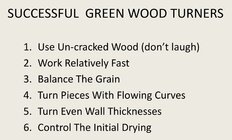
There was a thread on roughed out bowls.
Do people buy rough turned bowls?
I’ve seen a few turners selling rough turned walnut and cherry for around 12-15 $ a board foot. Not everyone has access to hardwoods or wants to deal with the mess of roughing out/coring. But I’m having a hard time thinking that many rough turned bowls are sold. I’m curious and half hoping you...
Last edited:
